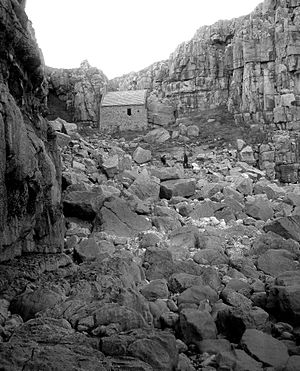Saint Govan facts for kids
Quick facts for kids St Govan |
|
|---|---|

St Govan's Chapel, Pembrokeshire built above the hermitage cell in the 13th century.
|
|
| Born | c.500AD County Wexford, Ireland. |
| Died | St Govan's head, Pembrokeshire 586 AD |
| Venerated in | |
| Feast | 26 March (8 April Old style) |
| Attributes | Celtic Rite |
Saint Govan (Welsh: Gofan) was a hermit who lived a quiet life. He made his home in a small crack in a cliff by the sea. This place is near Bosherston, in the beautiful Pembrokeshire Coast National Park in Wales. St. Govan lived there until he died in 586 AD. Later, in the 13th century, a special building called St. Govan's Chapel was built right over his small home. This spot is now known as St. Govan's Head.
Contents
Stories About Saint Govan
Many interesting stories are told about Saint Govan. One legend says he was an Irish monk. He traveled to Wales later in his life. He wanted to find the friends and family of his teacher, an abbot. Some say this abbot was Saint David or Saint Ailbe of Emly.
Another story connects Govan to Gawain. Gawain was a famous knight from the legends of King Arthur. He was one of King Arthur's Knights of the Round Table. In old Welsh, the name "Govan" means "Legendary Son of Caw." Caw was a leader from a group called the Picts. He was a rival of King Arthur.
The Pirate Attack
One day, pirates attacked Saint Govan. These pirates came from Ireland or a nearby island called Lundy Island. The story says the cliff suddenly opened up. It made a small crack just big enough for Govan to hide inside. He stayed there safely until the pirates left.
Govan was very thankful for this miracle. He decided to stay living on the cliff. He probably wanted to help warn the local people if the pirates ever came back.
Govan's Cave and Chapel
Saint Govan lived in a small cave within the cliff's crack. Today, visitors can reach this cave by walking down many stone steps. People say the number of steps changes depending on if you are going up or down!
The small stone chapel you see today was built over Govan's cave. It was built in the 13th century. However, people believe this spot was important for monks as early as the 5th century.
Govan used to catch fish for food. He also got water from two nearby springs. Both of these springs are now dry. One was where the chapel stands today. The other, lower down the cliff, later became a holy well. Another legend says you can see Saint Govan's handprints on the floor of his cave. People also believe his body is buried under the chapel's altar. The cave was once a popular place for people to make wishes.
The Bell Rock Legend
There is a special story about Saint Govan's silver bell. He supposedly kept this bell in the chapel's tower. When the bell rang, its sound was perfectly clear and beautiful.
But pirates heard the bell and stole it. Saint Govan was very sad. Then, angels flew down and took the bell from the pirates. They returned it to the hermit. To stop the pirates from stealing it again, the angels put the bell inside a huge stone. This stone is now called the Bell Rock. You can find it at the water's edge. The legend says that when Saint Govan "rang" the stone, its power became a thousand times stronger.
Images for kids


